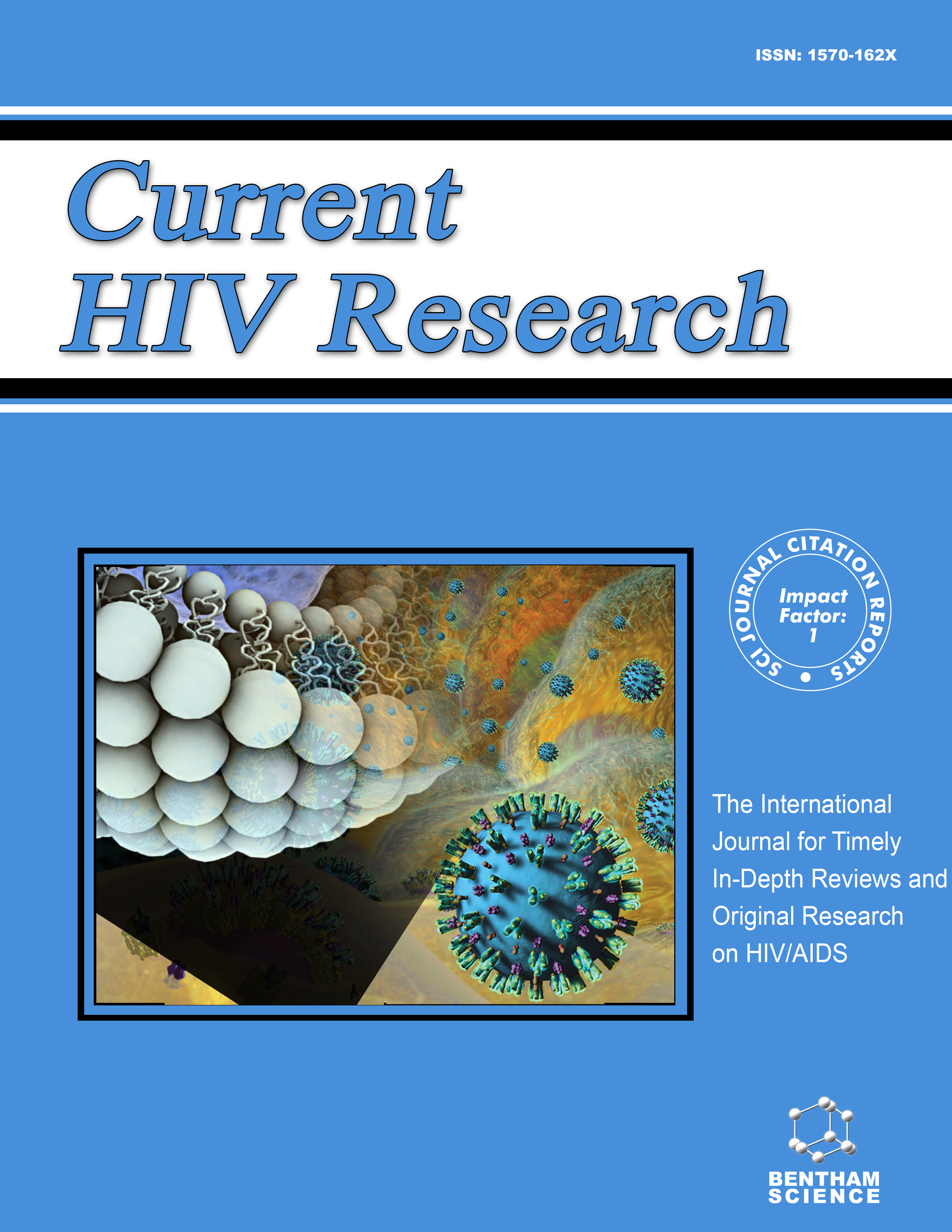- Home
- A-Z Publications
- Current HIV Research
- Previous Issues
- Volume 3, Issue 1, 2005
Current HIV Research - Volume 3, Issue 1, 2005
Volume 3, Issue 1, 2005
-
-
Editorial
More LessBy Ted M. RossCurrent HIV Research begins its third volume providing our readers with stimulating, timely, and in-depth articles on current HIV and AIDS research. As the Editor-in-Chief, I take this opportunity to thank the authors who contributed their ideas and insights into each article. The manuscripts published in volumes 1 and 2 highlight a wide array of innovative scientific and medical research on HIV / AIDS. Beginning with the Janua Read More
-
-
-
HIV-2 Infection and Chemokine Receptors Usage - Clues to Reduced Virulence of HIV-2
More LessAuthors: Jose M. Azevedo-Pereira, Quirina Santos-Costa and Jose Moniz-PereiraHuman immunodeficiency virus type 1 (HIV-1) and type 2 (HIV-2) are the causative agents of Acquired Immunodeficiency Syndrome (AIDS). Without therapeutic intervention, HIV-1 or HIV-2 infections in humans are characterized by a gradual and irreversible immunologic failure that ultimately leads to the onset of a severe immunodeficiency that constitutes the hallmark of AIDS. In the last two decades AIDS has evolv Read More
-
-
-
HIV-1 Prophylactic Vaccine Trials in Thailand
More LessThe HIV epidemic has resulted in medical, social and economic consequences. There is general agreement that a safe, effective and affordable preventive HIV vaccine is urgently needed to control the epidemic. To date, over 60 phase I / II trials of about 30 candidate vaccines have been conducted worldwide. In 1991, Thailand was selected by WHO, UNAIDS as one of the countries for potential HIV vaccine evaluation sites, Read More
-
-
-
HIV-1 Infection In Children: A Clinical and Immunologic Overview
More LessGlobally, HIV-1 is most often transmitted heterosexually so that nearly half of all infected adults are women of child-bearing age. Infants may acquire infection from vertical transmission. Without treatment most HIV-1 infected children in Africa die before their third birthday; as a result child mortality has increased overall by 35-50%, and by greater than 100% in areas of high seroprevalence. HIV-1 infection has a hetero Read More
-
-
-
The Role of Vpr in HIV-1 Pathogenesis
More LessAuthors: Joshua L. Andersen and Vicente PlanellesThe HIV-1 vpr gene is conserved among the human (HIV-1, HIV-2) and simian immunodeficiency viruses (SIV). HIV-1 vpr encodes a 96-amino acid, 14 kDa protein (Vpr). Research from a number of laboratories in the last decade has shown that Vpr performs multiple functions, including the induction of cell cycle arrest in the G2 phase, transactivation of the viral promoter, nuclear import of preintegration complexes, and ind Read More
-
-
-
Pathogenesis of Macrophage Tropic HIV-1
More LessAuthors: Paul R. Gorry, Melissa Churchill, Suzanne M. Crowe, Anthony L. Cunningham and Dana GabuzdaDespite numerous studies on the impact of viral diversity, human immunodeficiency virus type 1 (HIV-1)-specific immune responses and host factors on disease progression, we still do not have a firm understanding of the pathogenesis of HIV-1 infection. Rapid depletion of CD4+ T-lymphocytes has been associated with a switch in viral coreceptor usage from CCR5 to CXCR4 in approximately 40 to 50% of infected in Read More
-
-
-
HIV-1 TAR RNA: The Target of Molecular Interactions Between the Virus and its Host
More LessAuthors: Sylvie Bannwarth and Anne GatignolHIV-1 TAR RNA is the binding site of the viral protein Tat, the trans-activator of the HIV-1 LTR. It is present at the 5' end of all HIV-1 spliced and unspliced mRNAs in the nucleus as well as in the cytoplasm. It has a highly folded stem-bulge-loop structure, which also binds cellular proteins to form ribonucleoprotein complexes. The Tat-Cyclin T1-CDK9 complex is the main component in the trans-activation of HIV-1 and its affinit Read More
-
-
-
The Packaging and Maturation of the HIV-1 Pol Proteins
More LessAuthors: Melissa Hill, Gilda Tachedjian and Johnson MakThe Pol protein of human immunodeficiency virus type 1 (HIV-1) harbours the viral enzymes critical for viral replication; protease (PR), reverse transcriptase (RT), and integrase (IN). PR, RT and IN are not functional in their monomeric forms and must come together as either dimers (PR), heterodimers (RT) or tetramers (IN) to be catalytically active. Our knowledge of the tertiary structures of the functional enzymes is well Read More
-
-
-
Nef: “Necessary and Enforcing Factor” in HIV Infection
More LessAuthors: Ajith M. Joseph, Manish Kumar and Debashis MitraThe Human Immunodeficiency Virus -1 (HIV-1) Nef protein that was originally identified as a viral negative factor is a 27kDa myristoylated protein. However, this so called dispensable viral protein has emerged as one of the most important proteins for viral life cycle. Nef not only establishes the host cell environment suitable for viral replication and pathogenesis but also facilitates the progression of the infection into disease. Pre Read More
-
-
-
Syphilis and HIV Co-Infection: When is Lumbar Puncture Indicated?
More LessThe rate of syphilis / HIV co-infection amongst men who have sex with men (MSM) in large urban regions ranges from 20 to 70% [7]. Concurrent HIV infection can alter the clinical presentation of syphilis, the response to treatment, and complicate the diagnosis and clinical course of neurosyphilis [18]. Therefore whether to perform a lumbar puncture (LP) on every co-infected patient in order to diagnose neurosyphilis Read More
-
Volumes & issues
-
Volume 23 (2025)
-
Volume 22 (2024)
-
Volume 21 (2023)
-
Volume 20 (2022)
-
Volume 19 (2021)
-
Volume 18 (2020)
-
Volume 17 (2019)
-
Volume 16 (2018)
-
Volume 15 (2017)
-
Volume 14 (2016)
-
Volume 13 (2015)
-
Volume 12 (2014)
-
Volume 11 (2013)
-
Volume 10 (2012)
-
Volume 9 (2011)
-
Volume 8 (2010)
-
Volume 7 (2009)
-
Volume 6 (2008)
-
Volume 5 (2007)
-
Volume 4 (2006)
-
Volume 3 (2005)
-
Volume 2 (2004)
-
Volume 1 (2003)
Most Read This Month
Article
content/journals/chr
Journal
10
5
false
en


